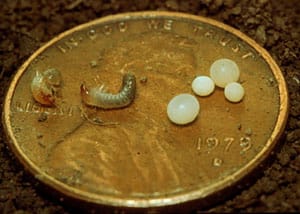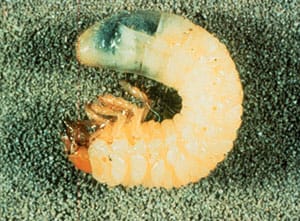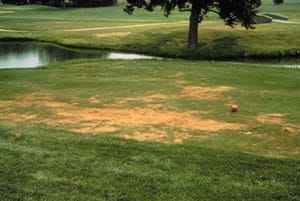Will Hudson, UGA Extension Entomologist

June and July are excellent times to prevent white grubs in turf. White grubs live in the soil and feed on the roots of turf. Most white grubs have a one year life cycle in Georgia. Adult beetles lay eggs in late spring or early summer. The eggs hatch into grubs which feed and grow through the summer and fall, then dig down to spend the winter deep in the soil. They become active as the soil warms in the spring, and feed for a few days to a few weeks, depending on the species. They then turn into pupae before emerging as adult beetles to continue the cycle.

White grubs are the immature stage of Scarab beetles like green June beetles, Japanese beetles, chafers and others. The scarabs are a large family of beetles, and there are perhaps two dozen different species of white grub that might be found feeding on the roots of turf in Georgia. Included in this group are some of the most serious insect pests a turf manager will face.
White grubs damage turf by feeding on the roots during the summer and fall and, to a lesser extent, in the spring before pupation. Very dry conditions can reduce survival of both eggs and small grubs.

Symptoms of white grub damage are similar to other factors that damage the root system – disease, soil compaction, poor fertility, or drought. Except for the green June beetle, grubs never come to the surface until they become adults. The only way to tell if a lawn is infested is to dig the grubs up.
To scout for white grubs, cut 3 sides of a square of turf and lay the grass back like a carpet. Dig gently in the soil to a depth of 4 inches and count the grubs you see. It is important to identify the grubs before you treat. The potential for turf damage is dependent on the number and types of white grubs present. Your county agent can help identify grubs or see the publication White Grub Pests of Turfgrass on the CAES Entomology Department website.
It is easiest to find white grubs in early spring and late summer (late August) when they are larger and easy to see. That is not the best time to treat, however. Treatments are more effective if applied while grubs are small. In most of Georgia, this means application in June or July for best control. Once white grubs get bigger, there are fewer effective options and higher pesticide rates will be required. Good soil moisture and watering in the pesticide is also important for white grub control.
See White Grubs of Turfgrass for good information on control measures. Consult the Georgia Pest Management Handbook for current pesticide recommendations. Follow all label recommendations when using any pesticide.
